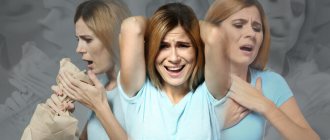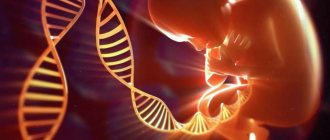Agitation is a state of pronounced emotional arousal, accompanied by a feeling of fear and anxiety, speech and motor restlessness. In a state of agitation, a person has an unconscious need to perform simple automatic movements or develops excessive fussiness.
Agitation – pronounced emotional arousal accompanied by fear
Causes
Agitation in some cases is a variant of the norm. For example, it can be triggered by a severe stressful situation - both acute and chronic.
More often, agitation is considered as one of the symptoms accompanying the following mental diseases:
- Alzheimer's disease;
- agitated depression;
- anxiety neurosis;
- catatonic schizophrenia;
- involutional depression;
- affective insanity.
The state of agitation can be provoked by the use of narcotic or psychotropic substances, or alcoholic beverages. In addition, pathology occurs against the background of severe infectious diseases.
Drugs, alcohol, psychotropic substances can lead to agitation
The mechanism of agitation development is complex and currently not fully understood. It is assumed that they play an important role:
- cerebral ischemia;
- metabolic disorders;
- influence of toxins;
- neuroreflex mechanisms;
- autoimmune and immune reactions;
- psychological characteristics of the individual.
Stages of development
There are three stages in the development of anxiety and depression. The first stage is characterized by increased sensitivity to life situations, events and stress. The patient reacts with irritation to minor failures. Anxiety in the first stage is mild, and panic attacks do not occur. The patient becomes tired after normal, previously non-stressful activities and housework. Sleep problems and difficulty falling asleep are already present.
In the second stage, psychosomatic symptoms and physical complaints intensify. Pain syndrome occurs in the muscular, abdominal and thoracic areas. At the same time, there is no physical explanation for the pain. Libido is altered - it is either too low or absent. The patient also complains of dizziness, rapid heartbeat and tachycardia. Anxiety increases and panic attacks occur periodically.
In the third stage, the symptoms of the previous stages worsen. Anxiety rises quickly. Personality changes occur, problems with self-esteem and devaluation arise. Apathy appears, mood becomes chronically low.
Symptoms of agitation are revealed at three specific stages of this pathology
Signs
It is characteristic of agitation that the patient usually does not notice this condition, despite the following pronounced signs:
- motor or speech restlessness;
- hand tremors;
- tachycardia;
- increased sweating;
- pale skin;
- rapid breathing;
- increased blood pressure;
- increase in body temperature.
During an attack, the patient cannot stay in one place for a long time. He loses the ability to reason correctly or establish complex cause-and-effect relationships.
According to medical statistics, the state of agitation is one of the main causes of traumatic injuries to medical personnel during working hours.
A person in a state of agitation experiences severe anxiety, and sometimes fear, and cannot fall asleep and calm down on his own. At the same time, attempts to control his behavior by family or friends often lead to an attack of aggression, up to and including injury to both the patient himself and those around him.
In cases where agitation occurs against the background of an illness, its symptoms are added to the signs listed above, for example, lack of criticality, delusions, hallucinations.
It is difficult for a person in a state of agitation to fall asleep
Agitation in children: characteristic features
In children, agitation occurs during postoperative awakening from anesthesia. It manifests itself as uncontrollable agitation, inappropriate actions, and anxiety.
The child is aggressive towards the doctor and parents, does not give in to persuasion, is irritable, cries for a long time and inconsolably. The condition can last up to half an hour from the moment of regaining consciousness. Then the baby calms down on his own or with the help of medications.
The syndrome is observed in children aged from one to seven. Usually found in patients with prenatal and postnatal disorders, birth injuries.
Diagnostics
Only a psychiatrist can diagnose the state of agitation after observing the patient for some time. Only by taking into account all the features can a specialist make a differential diagnosis between agitation and akathisia. In its manifestations, akathisia has much in common with agitation, but the treatment of these conditions requires a different approach.
More often, agitation is considered as one of the symptoms accompanying mental illness.
To determine the reasons that led to the occurrence of agitation, a laboratory and instrumental examination is carried out, including:
- blood test for thyroid hormone levels;
- blood test for alcohol content;
- general blood and urine analysis;
- blood pressure measurement;
- magnetic resonance or computed tomography of the brain;
- electroencephalography.
If necessary, other diagnostic methods can be used.
MRI of the brain reveals the causes of agitation
Symptoms
For a person in a state of agitation, the symptoms of this pathology remain invisible. But they can be noted by others. The main symptom is excitement. It is expressed in a number of internal vegetative disorders: trembling of the limbs, increased sweating, rapid heartbeat, shallow and rapid breathing, pale skin.
In addition to internal symptoms, there are also external symptoms that leave an imprint on behavior. A person in a state of agitation feels emptiness in his head, an almost complete absence of thoughts. At the same time, he loses the ability to reason sensibly and logically, to identify complex connections between cause and effect. All this is accompanied by a feeling of anxiety, fear and gradually turns into speech and motor disinhibition.
From the point of view of speech, agitation is expressed in the use of obscene expressions and phrases that are not characteristic of a given individual. There is clouding of consciousness, confusion of speech, repetitions of the same phrase are possible, unsuccessful attempts to complete a thought, rushing from one formulation to another.
From the point of view of motor skills, unconscious movements of the same type are noted, behavior is fussy, hands tremble, coordination of movements is impaired. The patient cannot sit in one place and walks from corner to corner. In a state of agitation, a person may unknowingly cause harm to himself or others. Spontaneous shouting and tics are also possible, especially if agitation is a symptom of a mental illness. In severe cases, delusional thoughts and ideas, auto-aggression, and suicidal attempts are possible.
When agitation is accompanied by depression, it is combined with apathy, depression, insomnia, and a constant feeling of causeless anxiety. In Alzheimer's disease, this disorder may have additional symptoms such as depression, hallucinations, behavioral disturbances, and wanderlust.
Treatment
Therapy for agitation should be aimed at eliminating the cause that caused its development. If this is a stressful situation, the use of tranquilizers is indicated. If agitation occurs as a result of the disease, it is treated.
Drug correction of agitation is carried out only as prescribed by a doctor and under his supervision. For this purpose, antipsychotics, antidepressants, and antianxiolytics can be used.
Antidepressants, antipsychotics, antianxiolytics and psychotherapy are the basis for the treatment of agitation
Psychotherapy plays an important role in eliminating agitation. It allows the patient to develop resistance to stressful situations, nervous and physical fatigue.
List of tranquilizer drugs
In the international Anatomical Therapeutic Chemical Classification (ATC), adopted by the Ministry of Health of the Russian Federation in 2002, anxiolytics (N05B) are included in the subsection of the section Drugs for the treatment of diseases of the nervous system (N) - Psycholeptics (N05). This subsection includes six groups of tranquilizers:
- benzodiazepine derivatives (N05BA): Chlordiazepoxide, Medazepam, Oxazepam, Potassium clorazepate, Lorazepam, Adinazolam, Bromazepam, Clobazam, Ketazolam, Prazepam, Alprazolam, Galazepam, Pinazepam, Camazepam. Nordazepam, Fludiazepam, Ethyl loflazepate, Etizolam, Clotiazepam, Cloxazolam, Tofisopam, Lorazepam in combination with other drugs;
- diphenylmethane derivatives (N05BB): Hydroxyzine, Captodiam, Hydroxyzine in combination with other drugs;
- carbamates (N05BC): Meprobamate, Emilkamate, Mebutamate, Meprobamate in combination with other drugs;
- dibenzo-bicyclo-octadiene derivatives (N05BD): Benzoctamine;
- Azaspirodecanedione derivatives (N05BE): Buspirone;
- other anxiolytics (N05BX): Mefenoxalone, Gedocarnil, Etifoxine, Fabomotizol.
Below we present two lists of tranquilizers that can be prescribed for neuroses and neurosis-like mental disorders based on elements of the leading symptoms.
Rice. 1. Formula of the first tranquilizer.
Target - elements of agitation
Mild and borderline mental disorders may be accompanied by elements of agitation: anxiety, panic, fear, overvalued thoughts of fear, obsessive fears, irritability, dysphoria, difficulty going to bed, decreased sleep duration, vegetative lability, vegetative crises. Elements of agitation are the target of the following tranquilizers:
- Diazepam;
- Alprolasam;
- Phenazepam;
- Lorazepam;
- Clonazepam;
- Flurazepam;
- Medazepam;
- Oxazepam;
- Triazolam;
- Bratizolam;
- Tetrazepam;
- Clobazam;
- Gidazepam;
- Nitrazepam;
- Flunitrazepam.
Target - elements of asthenia
Elements of agitation in reversible mental disorders include: mental and physical asthenia, chronic fatigue syndrome, hypochondria, impaired attention and memory, decreased intellectual activity, weakness, fatigue, lethargy, apathy, exhaustion, irritable weakness, autonomic lability, lack of vigor after sleep, anxiety . If such symptoms are present, the following tranquilizers are effective:
- Adaptol;
- Noofen;
- Trioxazine;
- Tofisopam;
- Buspirone.
The choice of a particular tranquilizer depends on the therapeutic goals, the nature of the disease and the individual characteristics of the patient’s health condition. The same applies to the dosage and timing of taking drugs in this group. Refusal of the doctor’s recommendations for taking an anxiolytic (frequency of dosage, recommended dosage, timing of treatment) is unacceptable.
Prevention
Prevention of agitation is the treatment of mental illness. Mentally healthy people need to avoid stressful situations and stop using alcohol and drugs. It is important that a patient prone to agitation receives regular psychotherapeutic support. The skills to cope with stress acquired during this course reduce the risk of relapse of the pathology.
Agitation in some cases is a variant of the norm. For example, it can be triggered by a severe stressful situation - both acute and chronic.
Risk factors
There are several triggers, that is, risk factors that cause the development of agitation. The main ones are:
- Acute stress reaction - occurs in mentally healthy people in extreme situations, after psychological trauma.
- Acute forms of infectious diseases with damage to the central nervous system by pathogen toxins.
- Epileptic disorders.
- Acute and chronic intoxication: alcohol, drugs, medications.
- Brain damage: traumatic brain injury, postoperative complications, progressive paralysis. Hypoxia, poisoning, state before sleep and coma.
- Mental illnesses: schizophrenia, bipolar affective disorder, manic agitation, depressive psychosis.
- Hallucinatory confusion with delirium and visual hallucinations.
- Hysterical state.
The risk group for the development of affective states includes older people and those whose nervous system cannot cope with the stress and emotional stress of everyday life.
Pedantry and anxiety
Those most susceptible to the manifestation and development of pathological agitation are those in whom accentuated traits predominate: pedantic people. It is very important for them to complete the task efficiently. They are sensitive to the accuracy of the work they have created, and if the slightest inaccuracies or inconsistencies arise, they react painfully and emotionally.
This provokes a constant state of anxiety and disrupts psychological balance. As a result, there is a high probability of a traumatic event. Anxious, pedantic people question their actions, decisions, and thoughts. They tend to underestimate their abilities and feel insecure in any non-standard situations.
Among the factors that can complicate and give rise to agitated psychosis, in this case, are usually called:
- difficulties with self-realization;
- problems in relationships with other people;
Photo by cottonbro: Pexels
- stressful situations leading to a rethinking of life values and prospects;
- financial instability;
- excessive criticism from loved ones or work colleagues.









